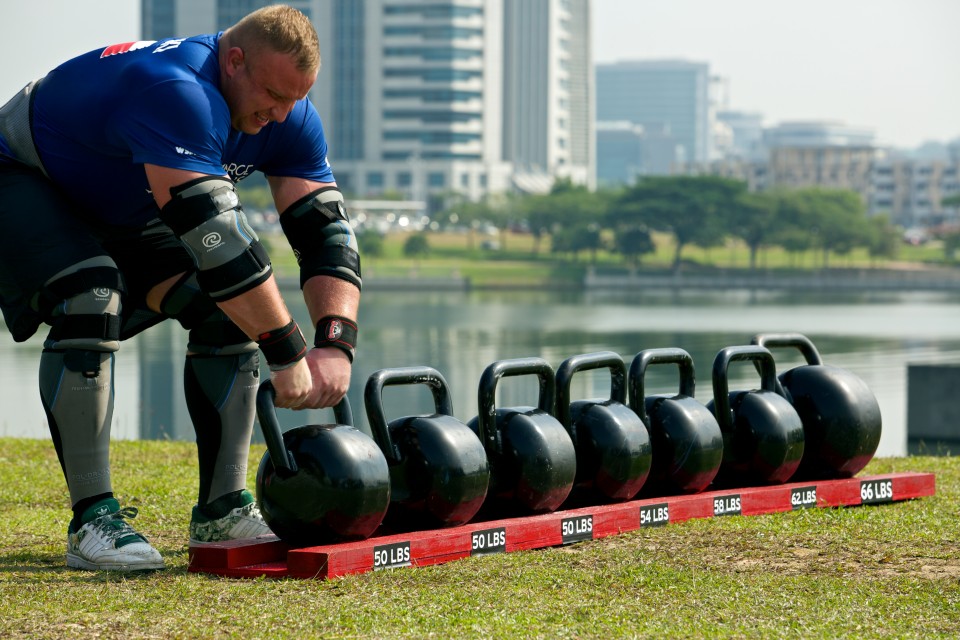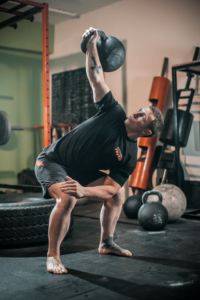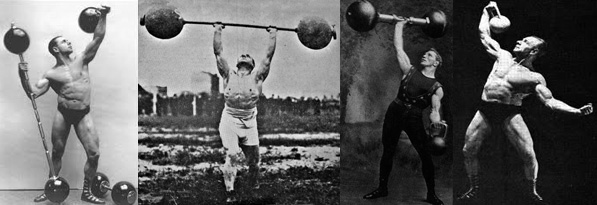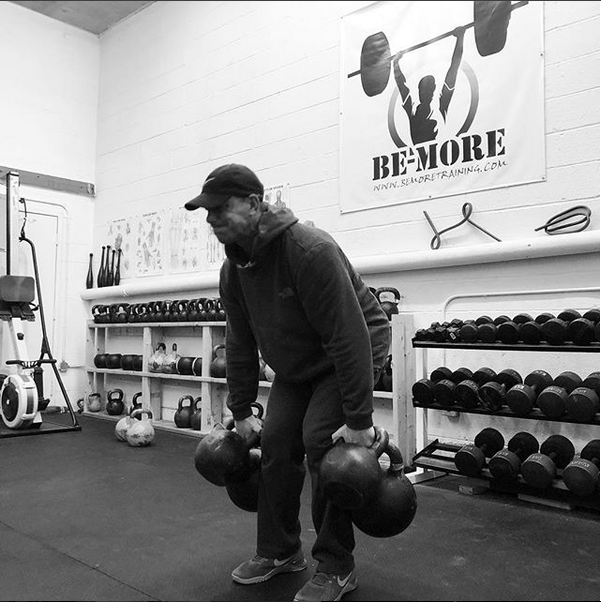
It should come as no surprise to anyone familiar with StrongFirst principles that the way we use a kettlebell has application to most any sport. There simply is no tool better for strength & conditioning than the kettlebell and StrongFirst leads the way for this training modality.
What is lesser known is how the kettlebell can be used in strength sports, a realm where the barbell reigns king.
Of course it’s obvious that when you compete with a barbell the majority of your training will be with a barbell, as it is in weightlifting and powerlifting. However, in a sport like strongman where the events are widely varied, there is much more room for a variety of kettlebell exercises.
What is the goal?
This is a question that should be asked for ANY kind of training. To answer this we will look at some of the most common strongman events:

I have arranged these events to fall under the categories of Deadlift, Press and Carry / Drag. This is not an exhaustive list and I have intentionally omitted other common events such as truck pulls and throwing events (mainly because they don’t fit nice and neatly into my table) but I will comment on those later.
The point is, every strongman contest will have some variation of 1) lower body pull 2) overhead press and 3) carry / drag. Most of the time, you will not know what events are being contested until a couple months out and even then they are subject to change. So you had better get strong at all of these movements!
That does not mean you have to do every kind of deadlift, and every kind of press, etc. It’s much better to pick one or two that you can really focus on and when it comes time to peak for competition, switch over to that lift which is being contested.
The Deadlift, Press & Carry/Drag is simply the foundation to build your training on. And that can be any kind of DL,

Ollie Quinn SFG Team Leader performing the bent press.
Pr, C/D, because your contest could be any kind of DL, Pr, C/D.
Grip
Grip strength is perhaps the most overlooked training in any sport but if you neglect it in strongman you’ll never place well in any meet. You are guaranteed to encounter one or more event where grip will be the limiting factor, even for people with strong hands.
Thickbars, farmers walks, carries, timed holds, etc. Something is going to test your grip. It might also be something less obvious like the wrist and open hand strength required to lift an atlas stone, or to pull a truck arm-over-arm.
Although a lot of contests these days allow for straps, wrist wraps and tacky to aid your grip, it makes good training sense to train the grip to be as strong as possible; don’t forget the principles of irradiation and neuromuscular efficiency!
Irradiation
Irradiation is when a muscle is working so hard that it recruits neighboring muscles to help support or assist in the force requirement. The tension irradiates from one muscle to the next and amplifies the strength of the primary and secondary movers.
Neuromuscular Efficiency
In simplest terms, neuromuscular efficiency is how well the central nervous system communicates with the muscles. It is estimated that we only activate 20-30% of our potential muscle, up to 50% in elite weightlifters (1), it’s a safety mechanism so we don’t tear them off the bone. We can however improve our muscle recruitment by improving our neurological efficiency. For visual aid in understanding how this relates to grip strength I direct you to the homunculus…

These models, from the London Museum of Natural Science, represent what our bodies would look like if they grew in proportion to our nervous system. It’s basically showing that we have more nerve endings in our hands than in any other part of the body.
The theory is that by strengthening your grip, you in turn strengthen your nervous system, thus improving neuromuscular efficiency. This is why Pavel has said that strengthening your grip is the fastest way to strengthen your body.
It is well known that grip strength closely correlates with full body strength. Many strength coaches use a hand dynamometer to measure the effectiveness of their athletes off-season training program. Well, it works both ways; strengthen your body and get stronger hands, strengthen your hands and get a stronger body. We will attack it from both directions because in strongman you need both!
Odd Events

Ben Eisenmenger SFG2 Beast Tamer & Strongman Competitor
Throwing events, crucifix holds, medleys and events that involve pushing or pulling a vehicle are all things that I would consider odd events. Expect to have at least one or two of them in a contest. These are events that would do you well to train the skill of but training them is not something that lays the foundation for contest prep.
If you are strong, you will do well at odd events with very little training. Once you learn the subtle nuances each event, there comes a point of diminishing returns.
Let’s take a throwing event for example. The mechanics of a throw, the trajectory, release, set up and follow through; these are all things you will need to practice. But throwing will not benefit your press the same way that pressing will benefit your throws (and your pressing).
In other words, there will be more carryover from your basic strength movements to the odd events (and standard events), than there will be vice versa.
Just get strong first and practice the sport specific skills more as you get closer to game day. Emphasis still remains on getting strong.
6 Weeks Out
This is the minimum time you’ll need to spend training events as they will be contested. If you’ve been on a steady diet of iron for a number of years 6 weeks will be enough time to peak for a meet. Here you will need to begin training most, if not all, events in a single day. Your last heavy workout will be 1 week before the contest and you will do every event near or close to contest weight within the given time frame.
If you’re an experienced competitor, this 6 week contest prep may be done with as little as one event day on the weekend, whereas the rest of the week you resume your normal schedule of barbell squats, cleans, presses and pulls. Of course you may also train events throughout the week as well, which may lead to faster progress, or, overtraining. But if you’re experienced you’ll know how to avoid overtraining.
If you’re a novice, it’s a roll of the dice and I’d recommend a more conservative approach. I’d rather have athletes going into a meet with gas in the tank rather than running on empty. The last thing you want is to try to carry a heavy yoke with knees that haven’t fully recovered from your last session.
That’s all I’ll say here about contest prep. The point of this article is not to prepare people for the specifics of any given contest or set of unknown events. The aim is to highlight how StrongFirst principles and kettlebell training can be used to develop the “raw materials” to compete successfully in the sport of strongman.
Off Season and Assistance Training
This is where and how we use kettlebells to train for strongman. I will list my favorite exercises and give an explanation of how they benefit the competitive strongman and follow that list up with a few sample workouts.

Get-Up
The Get-Up serves as a warm up / movement prep and full body strength lift for the strongman. The Get Up “fills gaps” in a routine full of brute strength and compound exercises. In a sport where “good technique” is determined by however you can lift the most weight, the Get Up will make sure you aren’t compensating for any deficiencies. You’ll be using muscles you didn’t know you had in strongman and the GU is a good way to address a lot of those muscles. Go heavy.
Swing
Anyone who has trained the swing before knows that it strengthens the hips, legs and back – you feel it after your first workout! The hinge movement is the same in the swing as it is in the deadlift, so it should come as no surprise that swings will help you pull more. I’ve had at least one guy deadlift 300 his first time ever touching a barbell and several ladies pull 200+ all thanks to the strength they built swinging. The ballistic nature of the swing will also aid in throwing events or anything you need to move quickly in.
Squat
If can squat 500 or more, you should be using a barbell for most of your squats. Even a pair of 48kg “Beasts” will only get you to a 212lb front squat, which is great but it won’t help your yoke walk. Besides, a pair of large kettlebells become cumbersome to the point of sacrificing heavier weight. Instead, use double kettlebell front squats for bracing the abs throughout the deep knee bend. Power breathing with all that weight resting on your ribs will do wonders for your core strength and that will translate directly to any kind of loaded front carry (sandbag, zercher, conan’s wheel, etc).
Push Press
Use double bells for this movement. It’s a good idea to clean every rep as well, but not always necessary. There is no strict press in strongman so use the legs as much as you want. If you know how to jerk – fine, but don’t get caught up in the techniques to make it efficient. Remember, brute strength and heavy weights. The Viking Push Press is another valid technique to use.
Bent Press
The Circus dumbbell is an event often included in strongman competitions today. It usually allows for a 2 hand clean and any style of 1 arm press. The Bent Press is a valid option. See SFG Team Leader Oliver Quinn win this event with a 190lb bent press in competition –
https://www.instagram.com/p/Ba68-OiHsmD/
Snatch
Use double bells for this movement. Technically more difficult than a single kettlebell snatch but still easier than a full squat barbell snatch, although that depends on who is teaching it. If you don’t have an SFG2 to work with, maybe leave the Double Bell Snatch and the Bent Press out. I’m sure there are far more people who know how to snatch a barbell but the double kettlebell snatch is a force to recon with.
Farmers Walk
Again, kettlebells might not cut it if you’re very strong but try taking a pair of 48’s around the block before you say that. On at least three occasions I have taken the Beasts for a 1/2 mile walk and once I carried a pair of 32’s for a mile. Carrying 2 bells in each hand is another option as well.

Craig Cusic getting ready to farmers walk a 40 & 48kg in each hand
Sample Program A - 1 event day per week MONDAY - Kettlebell Get-Up Swing Grip TUESDAY - Kettlebell Push Press Double Snatch Squat WEDNESDAY - Kettlebell Get-Up Bent Press Swing THURSDAY - Kettlebell Swing Push Press Squat Farmers Walk FRIDAY - Rest SATURDAY - Events Deadlift Press Carry / Drag Grip SUNDAY - Rest Sample Program B - 2 event days per week MONDAY - Kettlebell Get Up Swing Squat TUESDAY - Kettlebell Bent Press Push Press Swing WEDNESDAY - Events Press Deadlift Grip THURSDAY - Kettlebell Swing Snatch Farmers Walk FRIDAY - Rest SATURDAY - Events Press Carry / Drag Grip SUNDAY - Rest
Summary
The idea here is to find a place for kettlebells in Strongman training, not replace the barbell or event training; that would be foolish. Modern day competitors might find this a strange concept but historically the only people who even trained with kettlebells were strongmen!
The benefits of kettlebell training to the competitive strongman or strongwoman, are the same benefits offered to everyone else. Just to name a few…
- Stronger hips, shoulders and posterior chain
- Trains movements through multiple planes of direction
- Addresses stabilizer muscles that are neglected by “conventional” methods
- Builds a rock solid core that can still breathe under a heavy load.
All things important to the competitive strongman. This is the foundation of being strong.
So, get Strong First!

What brand of kettlebells are used for toss? Cannot find those wide handle kettlebells anywhere. Thank you
repfitness.com has slightly wider handles than most kettlebells, but most men will still have trouble getting both hands inside. The solution is simple… throw them with one hand!